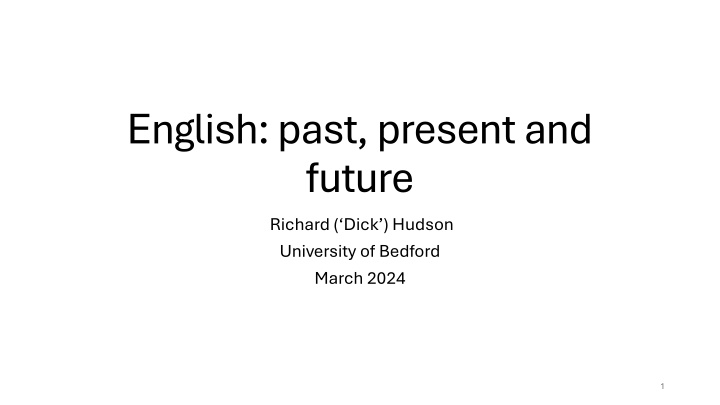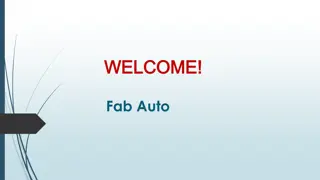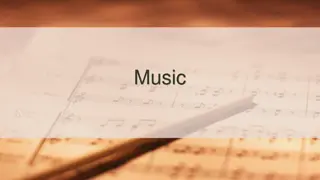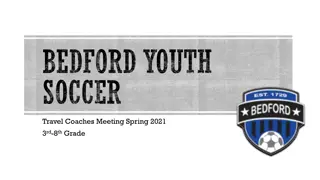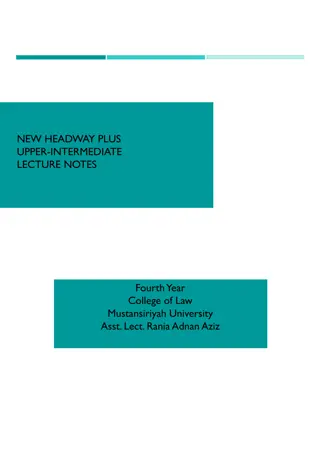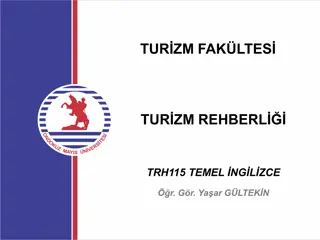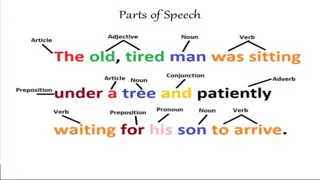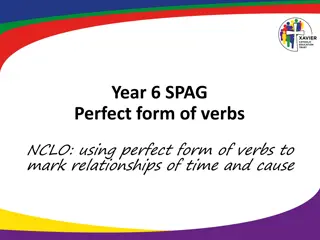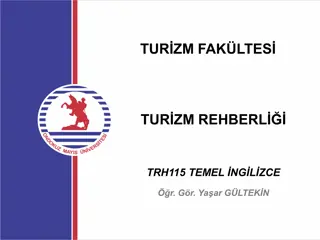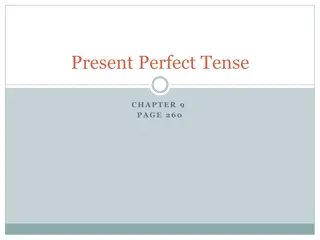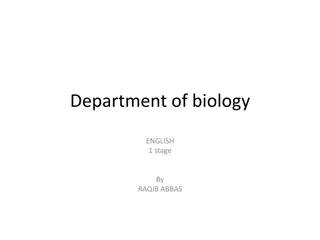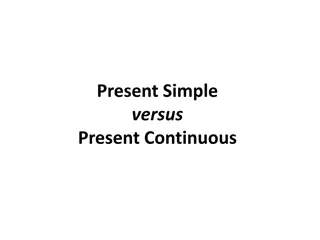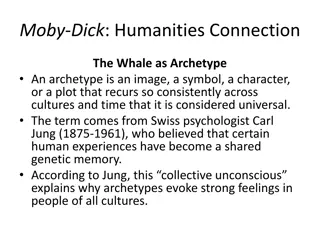English: Past, Present, and Future - Richard (Dick) Hudson, University of Bedford, March 2024
Delve into the evolution of English education through the works of Richard Hudson and historical texts like the Newbolt Report and Nesfield's analysis. Explore the past struggles and future aspirations of English teaching, as reflected in literature and educational systems. Uncover the foundations of liberal education and basic literacy, paving the way for a comprehensive understanding of the English language and its significance in academic settings.
Download Presentation

Please find below an Image/Link to download the presentation.
The content on the website is provided AS IS for your information and personal use only. It may not be sold, licensed, or shared on other websites without obtaining consent from the author.If you encounter any issues during the download, it is possible that the publisher has removed the file from their server.
You are allowed to download the files provided on this website for personal or commercial use, subject to the condition that they are used lawfully. All files are the property of their respective owners.
The content on the website is provided AS IS for your information and personal use only. It may not be sold, licensed, or shared on other websites without obtaining consent from the author.
E N D
Presentation Transcript
English: past, present and future Richard ( Dick ) Hudson University of Bedford March 2024 1
English past: How old are English teachers? Ask Google N-grams 2
English past Newbolt, Henry. 1921. The Teaching of English in England (The Newbolt Report).London: His Majesty s Stationery Office. The 'Position of English in the educational system of England' has scarcely any history. Of conscious and direct teaching of English the past affords little sign. Up to recent years our schools have failed to perceive either their need of English or their responsibilities towards English. Even now, the burden of proof still lies, strangely enough, on those who demand for it a basic place in our scheme of education. (Newbolt Report 1921) 3
Newbolt on liberal education the Renaissance educators did clearly perceive what was all too soon lost sight of, that the essence of a liberal education is the study of a great literature. They found in the Classics the source of all culture and enlightenment; the best that had been thought in the world expressed in the best possible way. . And the spirit in which they approached the literature which to them was all in all was the spirit which we desire to recapture on behalf of English today. 4
More Newbolt It may be objected that the aspirations of the Humanists have proved but a noble illusion, that few are found today to champion the system which they sought to establish, and that so far as Literature has been tried as the basis of education it has proved a failure. We reply that the Renaissance principle of Language and Literature as the basis of education never failed and could not fail. But this was the voice of the Upper Classes, educated in the Public Schools or by private tutors. 5
Meanwhile basic literacy Clement, Francis. 1576. The petie schole with an English orthographie, wherein by rules lately prescribed is taught a method to enable both a childe to reade perfectly within one moneth, & also the unperfect to write English aright. unknown. Preface: a word with the English teacher Many other books for basic literacy since the 17th century. Including English grammars 240 up to 1800 Another 1,000 in the 19th century 6
Summary of English past Two parallel traditions: English as the pillar of a liberal education re literature English as the route to literacy re language Liberal education and literature Dream of the upper classes Taught in universities Literacy and language Dream of the aspiring lower classes NB Universal popular education since 1870 But dominated in universities by historical linguistics. 9
English Present = since 1950s 1951. School Certificate > O-level GCE for top 20% 1965. + Certificate of Secondary Education (CSE) for next 40% 1966. Grammar + secondary modern schools > comprehensives 1988. O-level + CSE > GCSE for 100% 1990. + National Curriculum Big question: How should these changes affect English? 10
English and the National Curriculum 1990 = introduction of the National Curriculum How to resolve the tension between language and literature? English was problematic, so two reports were commissioned: 1988 Kingman Report on the teaching of English language 1989 Cox Report on how to integrate Kingman into the NC. One of the key recommendations was the central role of KAL Knowledge About Language Meanwhile, Linguistics had reached our universities 11
Six decades of Linguistics & English teaching 1959: Launch of The Linguistics Association of Great Britain 1964-71: Halliday s Linguistics and English Teaching project. 1975: Bullock Report supports Language across the Curriculum. 1980: Start of the Committee for Linguistics in Education. 1983: A-level English Language started. 1988/9: Two linguists on the Kingman and Cox committees. 1989-92: Lang in the National Curriculum (LINC) project for teachers. 2010: UK Linguistics Olympiad started. 2013: Four linguists drafted the Grammar Appendix for the NC. 12
KAL in Cox 1989 Two justifications for teaching pupils explicitly about language are, first, the positive effect on aspects of their use of language and secondly, the general value of such knowledge as an important part of their understanding of their social and cultural environment, since language has vital functions in the life of the individual and of society. 13
KAL in the first National Curriculum for English (1991) PS1,p.11: Pupils should be encouraged to respect their own language(s) or dialect(s) and those of others. Ages 11&12: pupils should be helped to recognise any differences in grammar or vocabulary between the local dialect of English and Standard English, recognising that local speech forms play an important part in establishing a sense of group identity. Age 16: Pupils should be able to demonstrate in discussion and in writing some understanding of attitudes in society towards language change and of ideas about appropriateness and correctness in language; e.g. comment on the arguments in a running correspondence in a newspaper 14
But assessment ignored KAL No national assessment of KAL. So children got no credit for KAL. So why should teachers teach it? Even if they had it themselves which most didn t. 15
Current (2014) NC for English Throughout the programmes of study, teachers should teach pupils the vocabulary they need to discuss their reading, writing and spoken language. It is important that pupils learn the correct grammatical terms in English and that these terms are integrated within teaching. Some other mentions of language. But no mention of KAL. 16
Current assessment KAL (Spelling and Grammar, SPaG) are tested at the end of KS2. High stakes, taken seriously by teachers, much anxiety. But almost nothing at GCSE. So SPaG dies in secondary children. Instead, one or two questions in each paper: 17
AQA June 2022 Paper 1, Q2/5 How does the writer use language here to describe the conflict between Kino and the scorpion? You could include the writer s choice of: words and phrases language features and techniques sentence forms. Extract from The Pearl, by John Steinbeck 18
Kino's breath whistled in his nostrils and he opened his mouth to stop it. And then the startled look was gone from him and the rigidity from his body. In his mind a new song had come, the Song of Evil, the music of the enemy, of any foe of the family, a savage, secret, dangerous melody, and underneath, the Song of the Family cried plaintively. Under her breath Juana repeated an ancient magic to guard against such evil, and on top of that she muttered a Hail Mary between clenched teeth. But Kino was in motion. His body glided quietly across the room, noiselessly and smoothly. His hands were in front of him, palms down, and his eyes were on the scorpion. Beneath it in the hanging box Coyotito laughed and reached up his hand toward it. It sensed danger when Kino was almost within reach of it. It stopped, and its tail rose up over its back in little jerks and the curved thorn on the tail's end glistened. The scorpion moved delicately down the rope toward the box. 19
AQAs answer Is it really a metaphor? In describing Kino s reactions to the danger, the writer is using an extended metaphor of the Song of Evil and the Song of the Family , to present the contrast between good and evil. This is illustrated by In his mind a new song had come, the Song of Evil and underneath, the Song of the Family cried plaintively . Here, by using this juxtaposition between good and evil, the writer portrays the Family threatened by the savage, secret, dangerous melody . This triplet of adjectives suggests a primitive, covert threat, embodied in the scorpion, forcing Kino to react swiftly and decisively to protect his family. 20
Where is the KAL? Extremely vague instructions and mark scheme. Shows detailed and/or perceptive understanding of language: Analyses the effects of the writer s choices of language Model answers avoid linguistics in favour of literary devices Looking for effects But without any theory of effects how language works. Let s apply linguistics to the passage 21
Kino's breath whistled in his nostrils and he opened his mouth to stop it. And then the startled look was gone from him and the rigidity from his body. In his mind a new song had come, the Song of Evil, the music of the enemy, of any foe of the family, a savage, secret, dangerous melody, and underneath, the Song of the Family cried plaintively. breath Juana repeated an ancient magic to guard against such evil, and on top of that she muttered a Hail Mary between clenched teeth. But Kino was in motion. His body glided quietly across the room, noiselessly and smoothly. His hands were in front of him, palms down, and his eyes were on the scorpion. Beneath it in the hanging box Coyotito laughed and reached up his hand toward it. It sensed danger when Kino was almost within reach of it. It stopped, and its tail rose up over its back in little jerks and the curved thorn on the tail's end glistened. The scorpion moved delicately down the rope toward the box. Under her 22
What should the GCSE test? KAL = Knowledge About Language = awareness of choices when turning an idea into words. = sensitivity to these choices = ability to talk about them = breadth of choices available (= Knowledge Of Language) E.g. We choose the focus of any description The whole person A part of that person NOT the supposed effects of these choices. Too difficult Too subjective 23
What does this GCSE really test? Spot the literary device and speculate about its effects. But that s not education! It doesn t help children to improve their own writing or reading. And it certainly doesn t help them to understand how language works. 24
No wonder A-level English is in decline! A-level English Literature, Language and Lang&Lit compared with Maths 16.0 14.0 12.0 10.0 Not even in top ten 8.0 6.0 Top A-level 4.0 2.0 0.0 1951 1970 1980 1990 2005 2015 2023 maths all % Eng lit all % Eng lang all % Eng Lang&Lit all % Current GCSE Eng Lang 25
English future: a dream English language separates from English literature. English literature becomes Literature And joins the other aesthetic arts: art and music Includes World Literature English language becomes English And joins the other languages: Foreign languages: French, etc Heritage languages: Welsh, etc Community languages: Bengali, etc. With close links to Maths 28
Why Maths? Language and maths are both Abstract Symbolic Distinct from the reality that they model Rule-governed There s a lot of maths in ordinary language, e.g. Maths: ab + ac = a(b+c) Language: big boy and big girls = big (boys and girls) The Linguistics Olympiad seems to demand the same thinking skills as maths. 29
The future English curriculum Skills Reading, writing, speaking, listening Knowledge History of English and Variation Structure of English Phonetics very popular in the early 20th century Phonology Phonics and spelling Morphology and vocabulary Syntax and idioms Semantics/pragmatics 30
Future English assessment Regular school assessment for monitoring purposes Based on known developmental stages Could be automated. GCSE certification of Skills Reading and writing Partly automated, based on linguistic maturity But not speaking and listening Too hard Too subjective KAL 31
KAL assessment Comments on texts to encourage noticing Comparisons re history or variation Very focused discussion of choices, e.g. re a single sentence. Comments on the system Explain some area of grammar Discuss personal or local grammar or vocabulary Comment on current changes Explain ambiguities (in jokes, headlines, etc) Discuss attitudes to language 32
English past, present and future Past Literature versus language Present Ditto: Literary devices but no KAL Future Literature no longer in competition with language Time for KAL BUT BA English doesn t give much KAL. So change will be needed in universities too. 33
Thank you This slideshow can be downloaded from https://dickhudson.com/talks/ 34
